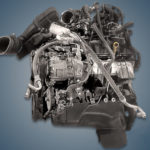The 4-liter VQ40DE engine has become not only one of the most reliable in the line of Nissan VQ gasoline units, but also the most voluminous in it. This is an enlarged version of the VQ35DE, which received an expansion of volume due to the size of the cylinders and the piston stroke. In all other respects, the unit was similar to its predecessor, here an aluminum cylinder block, a pair of aluminum DOHC heads with a CVTCS phase regulator on the intake and a timing chain drive. Since there are no hydraulic lifters, valve clearances will have to be adjusted every 100,000 km. The power unit appeared in 2005 in the USA, was developed for SUVs, since that time it has been equipped with the largest Nissan cars, as well as the Suzuki Equator until 2013. It has a gorgeous resource, which is unusual with modern disposability, the absence of problems and a huge potential for tuning.
The 4.0-liter V6 Nissan VQ40DE engine (or VQ40 for short) is installed in the Pathfinder SUV, as well as the pickup truck and minibus created on its basis.
The engine was installed on:
- Nissan Frontier 2 (D40) in 2004 – 2021;
- Nissan Pathfinder 3 (R51) in 2004 – 2014;
- Nissan Patrol 6 (Y62) in 2017 – …;
- Nissan Xterra 2 (N50) in 2005 – 2015;
- Suzuki Equator 1 (D40) in 2008 – 2012.
Specifications
| Manufacturer | Decherd Powertrain Plant |
| Also called | VQ40 |
| Production years | 2005 |
| Cylinder block alloy | aluminum |
| Fuel system | injector |
| Configuration | V6 |
| Valves per cylinder | 4 |
| Piston stroke, mm | 92 |
| Cylinder bore, mm | 95.5 |
| Compression ratio | 9.7 |
| Displacement, cc | 3954 |
| Power output, hp | 265/5600 269/5600 |
| Torque output, Nm / rpm | 381/4000 390/4000 |
| Fuel type | petrol |
| Euro standards | EURO 3/4 |
| Weight, kg | 190 |
| Fuel consumption, L/100 km (for Pathfinder 2008) — city — highway — combined |
18.7 10.5 13.5 |
| Oil consumption, gr/1000 km | up to 500 |
| Recommended engine oil | 5W-30 / 5W-40 / 10W-30 / 10W-40 |
| Engine oil capacity, liter | 5.1 |
| Oil change interval, km | 15000 |
| Engine lifespan, km | ~500 000 |
Disadvantages of the VQ40DE engine
- Nissan owners with such a unit often complain about fuel consumption, and not about breakdowns, but it still has one weak point. Due to low-quality fuel, the catalyst is destroyed, the crumbs of which are pulled into the cylinders, causing scuffing and oil burn.
- The cooling system of this engine is not thought out and it overheats quite often. If you do not carefully monitor the cleanliness of the radiators and the condition of its fans, then the valve cover gaskets will quickly harden and oil will flow into the candle wells.
- Also, the viscous coupling of the cooling fan is not very high here, and due to the lack of hydraulic compensators in the motor, the valve clearance will have to be adjusted.






